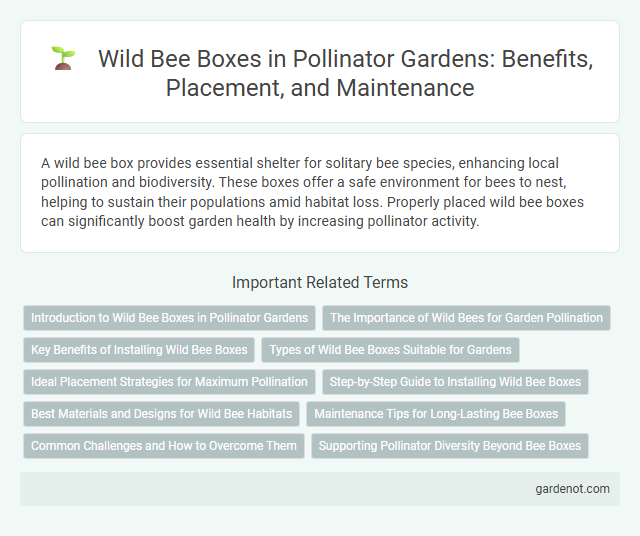A wild bee box provides essential shelter for solitary bee species, enhancing local pollination and biodiversity. These boxes offer a safe environment for bees to nest, helping to sustain their populations amid habitat loss. Properly placed wild bee boxes can significantly boost garden health by increasing pollinator activity.
Introduction to Wild Bee Boxes in Pollinator Gardens
Wild bee boxes provide essential nesting habitats for solitary bee species, enhancing biodiversity within pollinator gardens. These boxes support wild bee populations by mimicking natural cavities, promoting pollination and plant health. Installing wild bee boxes increases the diversity and abundance of pollinators, benefiting both native flora and agricultural crops.
The Importance of Wild Bees for Garden Pollination
Wild bees play a critical role in garden pollination, enhancing fruit and flower production by efficiently transferring pollen between plants. Installing a wild bee box provides a safe habitat, supporting their population growth and promoting biodiversity within the garden ecosystem. Conserving wild bees boosts natural pollination processes, reducing reliance on chemical pollinators and improving overall garden health.
Key Benefits of Installing Wild Bee Boxes
Installing wild bee boxes supports biodiversity by providing essential nesting habitats for solitary bee species, increasing local pollinator populations. These boxes enhance pollination efficiency for surrounding plants, boosting garden productivity and ecosystem health. Offering protection from predators and harsh weather conditions, wild bee boxes contribute to sustaining resilient pollinator communities.
Types of Wild Bee Boxes Suitable for Gardens
Wild bee boxes suitable for gardens include bamboo tube bundles, wooden block nests with drilled holes, and straw-filled containers, each mimicking natural habitats to attract solitary bees like mason and leafcutter species. Optimal designs feature varying hole diameters ranging from 2 to 10 mm to accommodate different bee sizes, enhancing nesting success and pollination efficiency. Placement in sunny, sheltered garden spots ensures warmth and protection, boosting wild bee activity and biodiversity.
Ideal Placement Strategies for Maximum Pollination
Placing wild bee boxes in sunny locations with minimal wind exposure maximizes pollination efficiency by attracting more native bee species. Positioning the boxes near diverse flowering plants ensures consistent food sources, supporting healthy bee populations throughout the growing season. Elevating the boxes 3 to 6 feet off the ground reduces predation risks and improves accessibility for wild bees, enhancing their nesting success and ultimate pollination impact.
Step-by-Step Guide to Installing Wild Bee Boxes
Installing wild bee boxes begins with selecting a sunlit, sheltered location ideally 3 to 6 feet above ground to attract native bee species. Secure the box firmly to a post or tree, ensuring it faces southeast to capture morning sunlight while avoiding heavy wind exposure. Regular maintenance includes cleaning the box annually in late fall to remove debris and parasites, promoting healthy pollinator populations year after year.
Best Materials and Designs for Wild Bee Habitats
Wild bee boxes crafted from untreated cedar or pine provide durable, weather-resistant habitats that mimic natural nesting conditions. Designs featuring varied hole sizes between 3-10 mm accommodate different wild bee species, enhancing biodiversity in the garden. Proper ventilation and drainage holes ensure a healthy environment, preventing mold and moisture buildup critical for wild bee survival.
Maintenance Tips for Long-Lasting Bee Boxes
Regularly clean wild bee boxes by removing debris and old nesting materials to prevent disease and parasite buildup. Place boxes in well-drained, sunny locations with some protection from harsh wind and rain to extend their lifespan. Inspect the boxes at least twice a year for signs of wear or damage and replace parts as needed to ensure a safe habitat for native pollinators.
Common Challenges and How to Overcome Them
Wild bee boxes often face challenges such as parasitic infestations, moisture buildup, and predation, which can reduce nest success and bee population growth. To overcome these issues, regular cleaning, proper placement in sunny, dry locations, and using predator guards help maintain a healthy habitat for wild bees. Monitoring for signs of disease and providing diverse native flowering plants nearby further supports their resilience and nesting success.
Supporting Pollinator Diversity Beyond Bee Boxes
Wild bee boxes provide essential nesting habitats that support diverse pollinator species including solitary bees, enhancing overall pollinator diversity in gardens. Integrating a variety of native plants and providing natural forage alongside bee boxes boosts nesting success and foraging opportunities for wild bees. This holistic approach strengthens local ecosystems by promoting pollinator health beyond solitary reliance on artificial nesting structures.
Wild bee box Infographic

 gardenot.com
gardenot.com